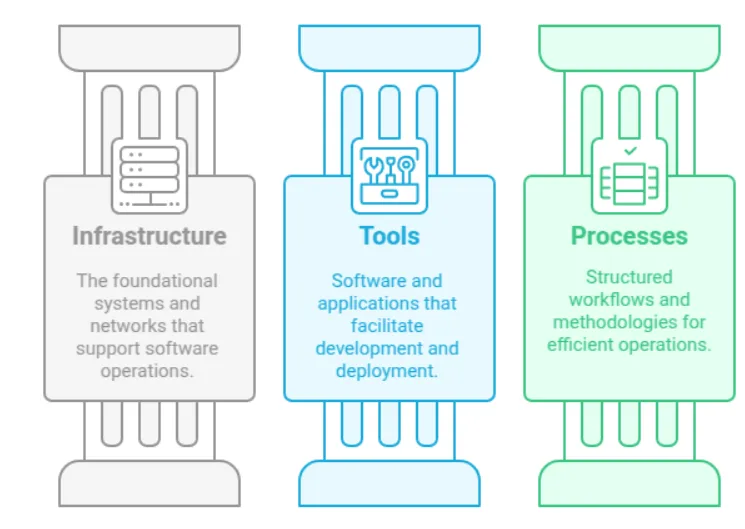March 12, 2025
From Startup to Enterprise: Scaling Your Tech Infrastructure with Platform Engineering

By Shailesh Davara
Improwised Technologies Pvt. Ltd.
From Startup to Enterprise: Scaling Your Tech Infrastructure with Platform Engineering

Components of Platform Engineering
Platform engineering involves several key components that are essential for its success:
-
Infrastructure as Code (IaC): This approach manages infrastructure configurations using code, allowing for automation, version control, and repeatability. IaC tools like Terraform and AWS CloudFormation are commonly used to ensure consistency and reduce errors in infrastructure deployments.
-
Modular and Scalable Architecture: Platform engineering emphasizes the development of modular architectures that can scale efficiently. This involves designing systems as collections of loosely coupled services or microservices, which enhance scalability, resilience, and maintainability.
-
API-First Approach: Adopting an API-first strategy allows developers to build new services on top of existing platforms without disrupting the underlying infrastructure. This approach facilitates integration and innovation by providing standardized interfaces for different components.
-
Continuous Integration and Continuous Deployment (CI/CD): Implementing CI/CD pipelines is critical for automating the build, test, and deployment processes. This ensures that changes are quickly and reliably pushed to production, supporting rapid iteration and feedback loops.
Implementing Platform Engineering for Scalability
To scale tech infrastructure effectively, organizations must focus on implementing platform engineering principles that support growth and adaptability:
Standardization and Automation
-
Standardized Infrastructure Services: By standardizing infrastructure services and automating their connectivity via APIs and low-code tools, organizations can present a uniform set of services across different environments. This simplifies management and reduces complexity, making it easier to scale infrastructure.
-
Infrastructure Automation: Automating infrastructure provisioning and management using IaC tools helps reduce manual errors and accelerates deployment timelines. This is particularly important for scaling, as it allows resources to be quickly allocated or deallocated based on demand.
Collaboration and Feedback Loops
-
Cross-Functional Collaboration: Close collaboration between platform engineers and other teams ensures alignment and effective communication. This is crucial for identifying and addressing scalability challenges early on.
-
Performance Metrics and Feedback: Defining clear performance metrics (such as deployment frequency and failure recovery time) helps measure the success of platform engineering efforts. Continuous feedback loops enable iterative improvements, ensuring that the infrastructure remains optimized for growth.
Emerging Trends in Platform Engineering
Several trends are reshaping the platform engineering landscape, particularly relevant for scaling tech infrastructure:
-
Serverless Computing: This model allows developers to create applications without managing servers, reducing operational overhead and enhancing agility. Serverless computing is ideal for scaling applications quickly in response to changing demand.
-
Edge Computing: By moving processing closer to data sources, edge computing reduces latency and bandwidth requirements. This is essential for real-time analytics and IoT applications, where rapid data processing is critical.
-
AI and Machine Learning Integration: AI improves infrastructure management by providing predictive analytics and automation capabilities. This integration drives greater efficiency, scalability, and resilience in tech infrastructure.
-
Sustainable Infrastructure Practices: As organizations focus on reducing their environmental impact, sustainable infrastructure practices become increasingly important. This includes energy efficiency, carbon neutrality, and the use of renewable resources in data centers.
Applying Platform Engineering to Networking
Think of platform engineering for networking as creating a blueprint for consistent network services. We standardize tools and processes, then use APIs to automate connections. This means your network is reliable and predictable across all platforms, and troubleshooting becomes much simpler.
Conclusion and Consequences
Implementing platform engineering is crucial for startups transitioning to enterprises, as it enables them to scale their tech infrastructure effectively. However, there are consequences to consider:
A failure to adopt platform engineering principles can severely hinder an organization’s ability to scale efficiently. This can lead to a cascade of negative consequences, including increased costs, reduced agility, and decreased competitiveness. Companies that lag in adopting these principles may find themselves struggling to meet growing demands, potentially experiencing system failures and a subsequent loss of market share. Furthermore, insufficient collaboration between platform engineers and other teams can create misaligned infrastructure and application development strategies, resulting in inefficient resource allocation and reduced system performance. Finally, the growing demand for scalable infrastructure, if not managed sustainably, can contribute to higher energy consumption and increased carbon emissions. Therefore, organizations must prioritize sustainable practices to mitigate these potentially harmful environmental consequences.
In summary, platform engineering is a critical strategy for scaling tech infrastructure from startup to enterprise. By focusing on modular architectures, automation, collaboration, and emerging trends like serverless computing and sustainable practices, organizations can ensure efficient growth and maintain a competitive edge in the market. However, neglecting these principles can have significant consequences, including reduced competitiveness and environmental impact.

November 19, 2025
Unlocking Developer Potential: How Platform Engineering Transforms Developer Experience

By Shyam Kapdi
Improwised Technologies
Pvt. Ltd.


By Shyam Kapdi
Improwised Technologies
Pvt. Ltd.

November 14, 2025
How to Build a High-Impact Internal Developer Platform: Step-by-Step Blueprint, Tools, and Best Practices

By Shyam Kapdi
Improwised Technologies
Pvt. Ltd.
Optimize Your Cloud. Cut Costs. Accelerate Performance.
Struggling with slow deployments and rising cloud costs?
Our tailored platform engineering solutions enhance efficiency, boost speed, and reduce expenses.
